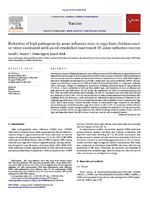Browse Items: 2
Reduction of high pathogenicity avian influenza virus in eggs from chickens once or twice vaccinated with an oil-emulsified inactivated H5 avian influenza vaccine
The negative impact of high pathogenicity avian influenza virus (HPAIV) infection on egg production and deposition of virus in eggs, as well as any protective effect of vaccination, is unknown. Individually housed non-vaccinated, sham-vaccinated and inactivated H5N9 vaccinated once or twice adult White leghorn hens were challenged…
Development of a new candidate H5N1 avian influenza virus for pre-pandemic vaccine production
Highly pathogenic H5N1 avian influenza viruses currently circulating in birds have caused hundreds of human infections, and pose a significant pandemic threat. Vaccines are a major component of the public health preparedness for this likely event. The rapid evolution of H5N1 viruses has resulted in the emergence of multiple clades with distinct…
 An official website of the United States government.
An official website of the United States government.



